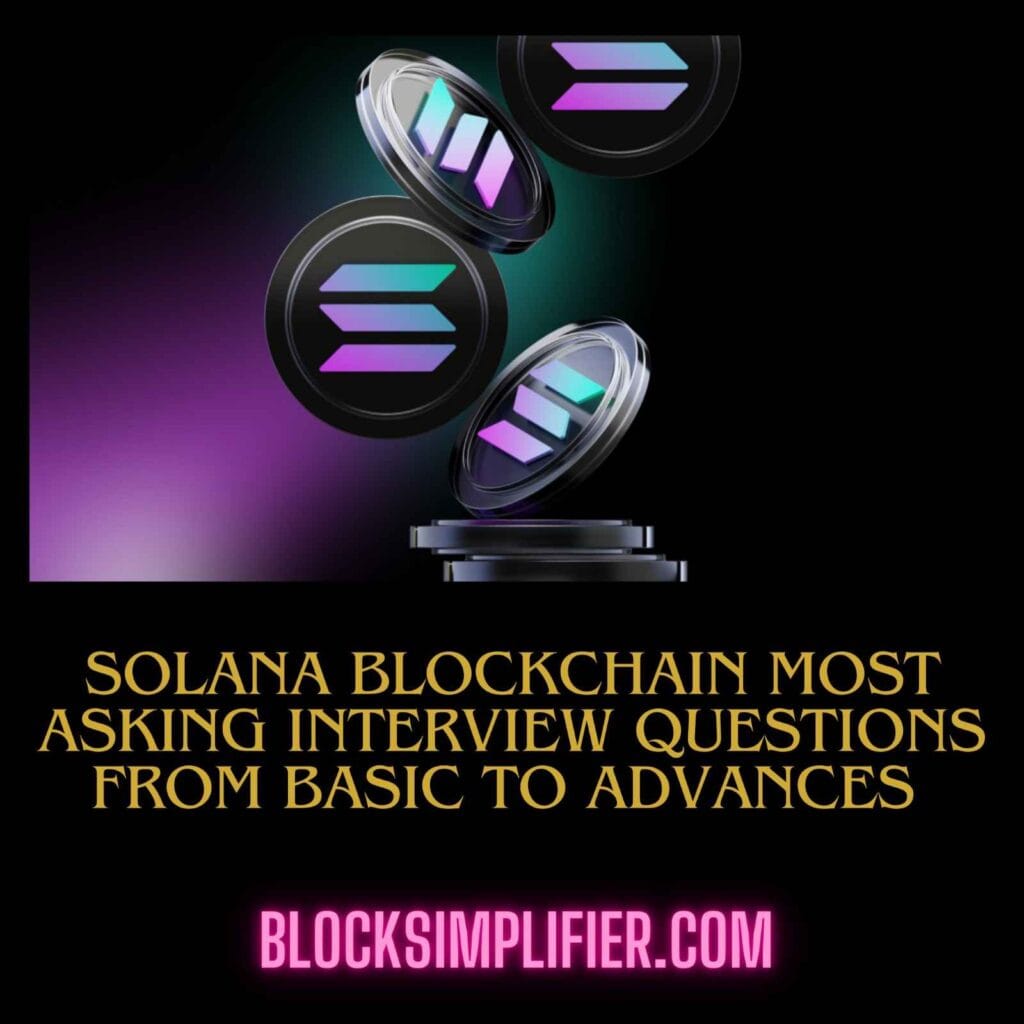In this article, we covered most asking Solana blockchain smart contract development Solana blockchain Most Interview Questions from Basic to advances
Table of Contents
Basic Questions
1. What is Solana, and how does it differ from Ethereum?
Solana is a high-performance blockchain designed for scalability and low transaction costs. It uses a unique consensus mechanism called Proof of History (PoH) combined with Proof of Stake (PoS) to process thousands of transactions per second.
Differences between Solana and Ethereum:
| Feature | Solana | Ethereum |
|---|---|---|
| Consensus Mechanism | PoH + PoS | Proof of Stake (PoS) |
| Transactions Per Second (TPS) | ~65,000 TPS | ~15-30 TPS |
| Block Time | ~400ms | ~12 seconds |
| Smart Contracts | Called “Programs” | Called “Smart Contracts” |
| Execution Model | Parallel execution (Sealevel) | Single-threaded execution (EVM) |
| Transaction Fees | Low (fractions of a cent) | Higher (varies with gas fees) |
Solana’s parallel execution model (Sealevel) enables multiple smart contracts to run simultaneously, whereas Ethereum executes transactions sequentially.
2. What are Solana smart contracts called, and the way do they work?
Solana Smart contracts are known as Programs.
How They Work:
- Programs are stateless and stored on-chain in executable accounts.
- They interact with accounts that hold data and state.
- Transactions ship instructions to the program, which executes them.
Unlike Ethereum, in which the smart agreement holds information, Solana separates common sense (packages) from information (accounts).
3. Which programming language is used for Solana Smart contracts?
Solana clever contracts are frequently written in Rust and C.
- Rust is favored because of its memory safety and performance.
- C can be used but is less common.
- Anchor is a Rust-based framework that simplifies Solana development.
4. What is the role of Rust in Solana smart contract development?
Rust plays a crucial role in Solana development because:
It offers memory safety (no null pointers or buffer overflows).
It is optimized for performance, allowing Solana to handle high TPS.
It provides low-level control, which is essential for blockchain execution.
It supports parallel execution, aligning with Solana’s architecture.
5. How does Solana achieve high scalability and low transaction costs?
Solana achieves scalability through several innovations:
- Proof of History (PoH) → Orders transactions before consensus to increase speed.
- Sealevel → A parallel execution engine that processes multiple transactions simultaneously.
- Gulf Stream → A transaction forwarding protocol that reduces mempool congestion.
- Turbine → A block propagation system that ensures fast data transfer.
- Pipelining → Optimizes data validation across the network.
- Low Fees → Due to high throughput, transaction charges remain low (fractions of a cent).
These features enable excessive TPS (~65,000) and low prices.
6. What is the Proof of History (PoH) mechanism in Solana?
Proof of History (PoH) is a cryptographic clock that timestamps transactions before they input the blockchain.
How it really works:
- A leader node generates a sequential, verifiable timestamp for transactions.
- Validators use these timestamps to order transactions before running consensus.
- This reduces the want for nodes to speak significantly, making transaction processing faster and extra green.
PoH improves Solana’s velocity as compared to Ethereum, which calls for transaction validation thru traditional consensus.
7. What are the key components of a Solana program?
A Solana program consists of:
- Program (Smart Contract) – The on-chain executable logic.
- Accounts – Store state and interact with programs.
- Instructions – Commands sent to programs for execution.
- Transactions – Batches of instructions executed in a single atomic operation.
- Signers – Entities that authorize transactions (wallets, PDAs).
- Cross-Program Invocation (CPI) – Allows one program to call another.
8. What are accounts in Solana, and how do they function?
Accounts in Solana store data and state, similar to Ethereum’s contract storage.
Types of Accounts:
- Executable Accounts – Store programs (smart contracts).
- Non-Executable Accounts – Hold data and state for users and programs.
Key Features of Solana Accounts:
- Owned by Programs – Programs control access to data.
- Rent System – Accounts must maintain a balance to remain active.
- Fixed-size Data – Unlike Ethereum’s dynamic storage, Solana accounts have pre-allocated memory.
9. What is the difference between executable and non-executable accounts in Solana?
| Account Type | Description |
|---|---|
| Executable Account | Stores Solana programs (smart contracts). They are immutable after deployment. |
| Non-Executable Account | Stores state and data related to programs and users. |
Example:
- A Token Account (holding SPL tokens) is non-executable.
- A Token Program (handling token transfers) is executable.
10. What is the purpose of the Anchor framework in Solana?
The Anchor framework simplifies Solana smart contract development by:
Reducing boilerplate code – Automates serialization, account validation, and error handling.
Providing declarative macros – Similar to Ethereum’s Hardhat but optimized for Solana.
Enhancing security – Automates checks for account ownership, mutability, and signer requirements.
Easy testing & deployment – Integrated CLI tools for quick program management.
Intermediate Questions
1. How do you create a easy Solana application the usage of Rust?
To create a Solana application in Rust, comply with those steps:
Step 1: Install Dependencies
Ensure you’ve got Rust and Solana CLI set up:
rustup install stable
cargo install --git https://github.com/solana-labs/solana solana-cli
Step 2: Create a New Solana Program
Run the following command:
cargo new my_solana_program --lib
cd my_solana_program
Step 3: Modify Cargo.toml
Add the required Solana dependencies:
[dependencies]
solana-program = "1.18.0"
Step 4: Write the Solana Program (in lib.rs)
use solana_program::{
account_info::{next_account_info, AccountInfo},
entrypoint,
entrypoint::ProgramResult,
pubkey::Pubkey,
msg,
};
// Define the entry point of the Solana program
entrypoint!(process_instruction);
fn process_instruction(
_program_id: &Pubkey,
_accounts: &[AccountInfo],
_instruction_data: &[u8],
) -> ProgramResult {
msg!("Hello, Solana!");
Ok(())
}
This simple program logs a message when executed.
Step 5: Build and Deploy
cargo build-bpf
solana program deploy target/deploy/my_solana_program.so
This compiles and deploys the smart contract to the Solana blockchain.
2. What are PDAs (Program Derived Addresses), and why are they vital?
Program Derived Addresses (PDAs) are special addresses that programs can manipulate but personal keys do not exist for them.
Why are PDAs Important?
- Secure Data Ownership – PDAs allow a smart contract to own an account.
- No Private Key – Unlike normal accounts, PDAs are derived from a program ID and a seed.
- Used in On-Chain Data Storage – NFT metadata, user balances, and escrow accounts use PDAs.
Example: Generate a PDA in Rust
let (pda, _bump) = Pubkey::find_program_address(
&[b"my_seed"],
program_id
);
Here, the PDA is derived from program_id and "my_seed".
3. How do you handle data serialization and deserialization in Solana programs?
Solana uses Borsh and Anchor’s serialization tools for handling structured data.
Using Borsh for Serialization
use borsh::{BorshSerialize, BorshDeserialize};
#[derive(BorshSerialize, BorshDeserialize)]
pub struct MyData {
pub counter: u32,
}
Reading and Writing Data in a Program
let data = MyData { counter: 42 };
let mut account_data = &mut account.try_borrow_mut_data()?;
data.serialize(&mut *account_data)?;
This ensures structured data can be efficiently stored in accounts.
4. Explain the concept of rent in Solana and how accounts are managed.
In Solana, accounts must maintain a minimum balance to stay active, called rent.
How Rent Works:
- Accounts pay rent unless they meet the minimum balance for exemption.
- Rent-exempt accounts do not lose SOL over time.
- To make an account rent-exempt, use:
solana_program::sysvar::rent::Rent::default().minimum_balance(account_size)
Rent-Exempt Account Creation
invoke(
&system_instruction::create_account(
payer.key,
account.key,
Rent::default().minimum_balance(account_size),
account_size as u64,
program_id,
),
&[payer.clone(), account.clone()],
)?;
This ensures the account has enough SOL to remain active.
5. How does cross-program invocation (CPI) work in Solana?
CPI (Cross-Program Invocation) allows one smart contract to call another.
Example: Calling Another Program
invoke(
&instruction::new_instruction(
called_program_id,
&[account.clone()],
&[],
),
&[account.clone()]
)?;
This enables interaction with other on-chain programs, such as the Token Program.
6. What is a Solana Token Program, and how do you create an SPL token?
The Solana Token Program (SPL) is used to create and control fungible tokens (like ERC-20).
Steps to Create an SPL Token
- Install Solana CLI and SPL Token Program
cargo install spl-token-cli - Create a New Token
spl-token create-token - Create a Token Account
spl-token create-account <TOKEN_ADDRESS> - Mint Tokens
spl-token mint <TOKEN_ADDRESS> 1000
This creates an SPL token that can be transferred and used in Solana programs.
7. How do transactions and instructions work in Solana?
A transaction in Solana contains one or more instructions.
Structure of a Transaction
let instruction = Instruction::new_with_bincode(
program_id,
&data,
vec![AccountMeta::new(account_pubkey, false)]
);
let transaction = Transaction::new_signed_with_payer(
&[instruction],
Some(&payer_pubkey),
&[&payer],
recent_blockhash,
);
This sends a transaction with an instruction to execute a program.
8. What is the difference between invoke and invoke_signed in Solana?
| Function | Purpose |
|---|---|
invoke | Calls another program without a PDA signing. |
invoke_signed | Calls another program with a PDA signature. |
Example of invoke_signed
Used when a PDA needs to sign a transaction:
invoke_signed(
&instruction,
&[pda_account.clone()],
&[&[b"seed", &[bump]]]
)?;
This allows PDAs to execute transactions, enabling escrow contracts and staking systems.
9. How do you sign transactions in Solana smart contracts?
Signatures are required for authorizing transactions.
Example: Signing a Transaction in Rust
let message = Message::new(&[instruction], Some(&signer_pubkey));
let transaction = Transaction::new(&[&signer], message, recent_blockhash);
- Signer wallets (like Phantom) sign transactions before sending them to the blockchain.
- Programs cannot sign transactions directly unless using PDAs.
10. How do you test and deploy Solana smart contracts using Anchor?
Testing Solana Programs in Anchor
- Write a test file (
tests/basic.ts)it("calls the Solana program", async () => { const tx = await program.methods.processInstruction().rpc(); console.log("Transaction Signature:", tx); }); - Run Tests
anchor test
Deploying a Solana Program
- Build the Program
anchor build - Deploy to Localnet
anchor deploy - Deploy to Mainnet/Testnet
solana program deploy target/deploy/my_solana_program.so
Advanced Questions
1. How does Solana handle parallel execution of transactions?
Solana achieves parallel transaction execution using Sealevel, its parallel execution engine.
Key Mechanisms:
- Account-based Parallelism:
- Transactions specify which accounts they read and write.
- Transactions without conflicting accounts run in parallel.
- Compute Units & Runtime Scheduling:
- Each transaction consumes a fixed number of compute units (CUs).
- The runtime schedules transactions in parallel using CPU threads.
Example: Parallel Execution
- Transactions A & B access different accounts → Execute in parallel.
- Transactions C & D modify the same account → Execute sequentially.
2. What are the security best practices for developing Solana smart contracts?
Best Practices for Solana Security:
- Account Ownership Checks:
- Verify the owner of accounts before modifying them.
require!( account.owner == expected_program_id, CustomError::InvalidOwner ); - Replay Attack Prevention:
- Use unique nonces or recent blockhash.
- Prevent Unauthorized Invocations:
- Use PDAs with controlled authority.
- Limit Compute Usage:
- Optimize loop iterations and instruction execution.
- Secure Cross-Program Calls:
- Always validate external program interactions.
3. How do you prevent replay attacks in Solana transactions?
Replay Attacks occur when an attacker resubmits a past transaction to manipulate funds.
Preventing Replay Attacks
Use Recent Blockhash
- Transactions must contain a recent blockhash (valid for 150 blocks).
- The Solana runtime rejects duplicate transactions with the same blockhash.
const { blockhash } = await connection.getRecentBlockhash();
const transaction = new Transaction().add(instruction);
transaction.recentBlockhash = blockhash;
Use Unique Nonces for PDAs
- Ensure PDA-based accounts store unique, time-sensitive data.
4. Explain the Solana account model and how it differs from Ethereum’s state model.
| Feature | Solana | Ethereum |
|---|---|---|
| State Model | Account-based | Account-based (EVM) |
| Execution | Parallel (Sealevel) | Sequential (EVM) |
| Data Storage | Accounts with explicit ownership | Contract Storage (Key-Value) |
| Gas Fees | Compute Units (CUs) | Gas (Variable Fees) |
- Solana Accounts store:
- Data (up to 10MB per account)
- Program Ownership
- Rent Balance
- Ethereum Storage:
- Smart contracts store state internally.
5. How do you interact with a Solana program from a frontend using web3.js or Solana SDK?
Using @solana/web3.js
import { Connection, PublicKey, Transaction } from "@solana/web3.js";
// Connect to Solana
const connection = new Connection("https://api.mainnet-beta.solana.com");
// Fetch Account Info
const accountInfo = await connection.getAccountInfo(new PublicKey("ACCOUNT_ADDRESS"));
console.log(accountInfo);
Sending a Transaction
const transaction = new Transaction().add(
new TransactionInstruction({
keys: [{ pubkey: programId, isSigner: false, isWritable: true }],
programId,
data: Buffer.alloc(0),
})
);
await sendAndConfirmTransaction(connection, transaction, [walletSigner]);
This sends an instruction to a smart contract from the frontend.
6. How do you handle upgradeable Solana programs?
Solana uses the BPF Upgradeable Loader for on-chain program upgrades.
Steps for an Upgradeable Program:
- Deploy the Program
solana program deploy --upgradeable my_program.so - Upgrade the Program
solana program deploy --program-id <PROGRAM_ID> my_updated_program.so - Set an Upgrade Authority
- The program owner must sign upgrades.
7. What are Solana compute units, and how do you optimize them?
Compute Units (CUs) measure execution cost.
Optimizations:
Reduce Loop Iterations
Use Account Data Efficiently
Minimize Cross-Program Invocations (CPI)
msg!("Optimizing Compute Units");
A transaction exceeding the CU limit fails with Out of Compute Budget error.
8. How do you implement multisig functionality in a Solana program?
Multisig requires N-of-M signers before executing transactions.
Example: Multisig Validation
require!(
signers.iter().filter(|s| s.is_signer).count() >= threshold,
CustomError::NotEnoughSigners
);
This checks if enough signatures are present.
9. Explain how Solana achieves deterministic execution with Sealevel.
- Sealevel Engine enables parallel processing.
- Non-overlapping accounts execute in parallel.
- Uses Compute Budgeting to ensure fairness.
10. How do you debug Solana smart contracts effectively?
Use msg!() for Logging
msg!("Debugging Step 1: Before Execution");
Use Solana Explorer for Transaction Logs
Run Tests in Anchor
anchor test
Scenario-Based Questions
1. If you need to store large amounts of data in Solana, how would you handle it?
- Use multiple accounts (each up to 10MB).
- Use off-chain storage (IPFS, Arweave) with a reference in an on-chain PDA.
2. What would you do if your Solana program runs out of compute units?
- Profile Compute Usage
- Reduce Nested Loops & CPIs
- Optimize Data Access
- Increase Compute Budget
const modifyComputeUnits = ComputeBudgetProgram.setComputeUnitLimit({
units: 1_400_000,
});
3. How would you implement a decentralized exchange (DEX) on Solana?
- Use Serum Orderbook for order matching.
- Create a Swap Pool for AMM-like trading.
- Use PDA-based Escrow for Trade Security.
4. How can you ensure an NFT minting program on Solana is secure?
Use PDAs to store minting authority
Limit One Mint Per User
Require Signer Verification
require!(payer.is_signer, CustomError::Unauthorized);
5. How would you design a staking smart contract on Solana?
- Create a PDA to track staked amounts.
- Use Time-Based Rewards Calculation.
- Lock Tokens with Withdraw Conditions.



